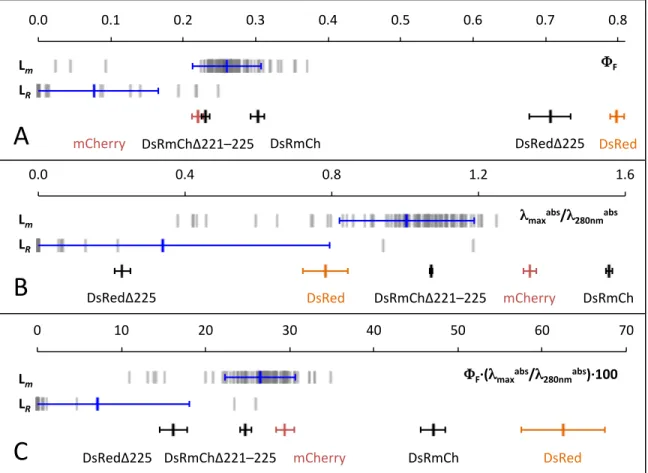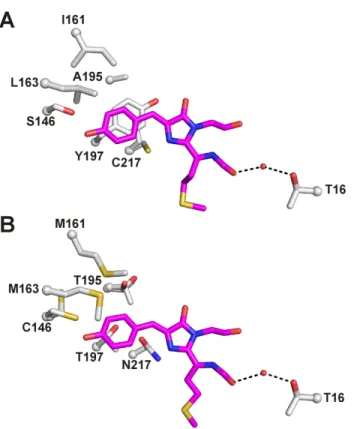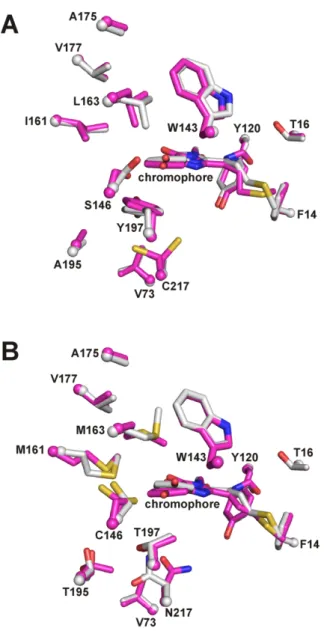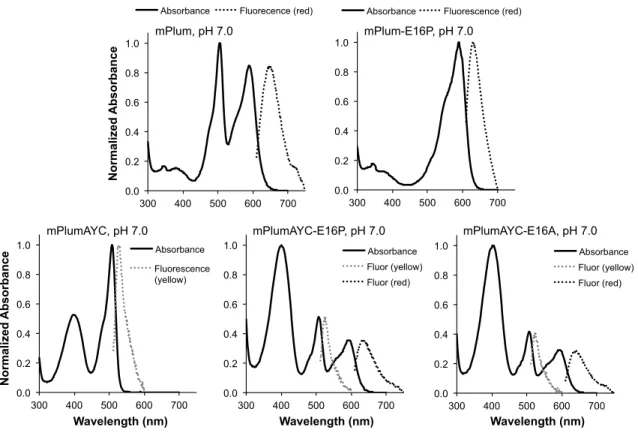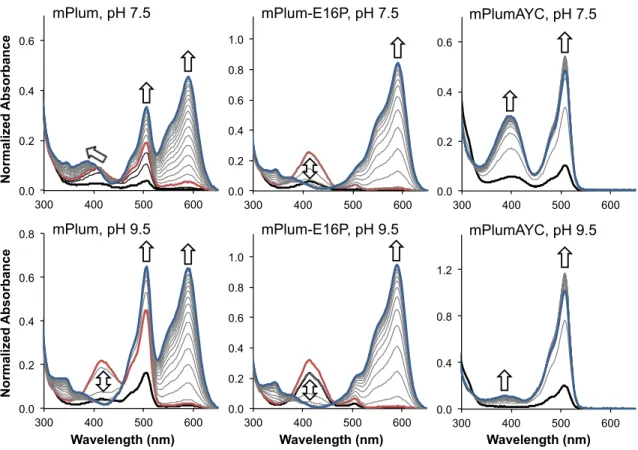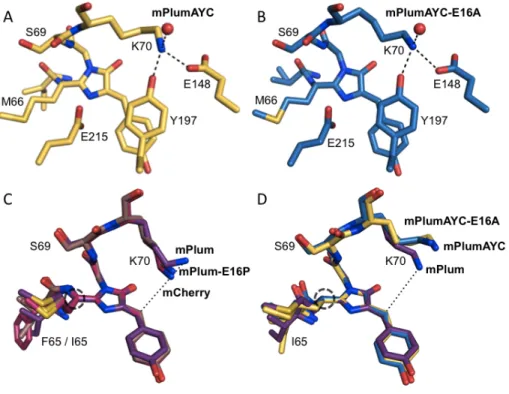Zollars for help in performing the occluded volume solvation method, Jens Kaiser for help in solving crystal structures and collecting diffraction data, Pavle Niklovski for setting up crystallization screens, and Sonja Hess, Robert L.J. We thank the Gordon and Betty Moore Foundation for support of the Molecular Observatory at Caltech and the USA. We would like to thank the Gordon and Betty Moore Foundation for supporting the Molecular Observatory at Caltech.
The first part, Chapters 2 and 3, of the thesis focuses on the application of rational design and CPD to the remnants of the FP core. In 2008, the Nobel Prize in Chemistry was awarded "for the discovery and development of the green fluorescent protein GFP" [1]. The same key steps are thought to underlie the initial process of chromophore formation regardless of the final covalent structure [5, 6].
Countless mutagenesis protocols have probed which residue substitutions allow chromophore formation by modulating various properties of the protein [4], such as maturation rate [15], stability [16], emission wavelength [17- 19] and fluorescence brightness [20 , 21]. The first part, chapters 2 and 3, of the thesis focuses on the implementation of rational design and.
Generation of Longer Emission Wavelength Red Fluorescent Proteins Using Computationally Designed Libraries
In addition, crystal structures of mRojoA and mRouge allowed us to verify the fulfillment of the interactions assumed to cause redshifts, supporting their contribution to the observed redshifts. The additional double bond expands the size of the chromophore conjugated system, leading to an increase in emission wavelength. Design hypothesis I (Fig. 1A) involves stabilization of the excited state by H-bonding to the acyl imine oxygen of the chromophore.
The aim was to preferentially stabilize the resonance shape of the chromophore in which the negative charge is located. Furthermore, in the course of this work, the crystal structure of the far-red RFP Neptune demonstrated a water-mediated H-bond between the acylimine oxygen and the adjacent residue S28, leading to red-shifted excitation and emission [14]. Positions 175 and 177 were also varied, as they were suggested to influence the polarization of the chromophore [5].
In all the designs, all 20 amino acids were allowed at each of the designed positions. This interaction should stabilize the resonance form of the chromophore in which negative charge is localized on the acylimine oxygen.
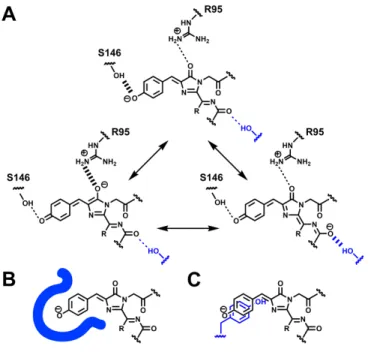
Supporting Information
Poor electron density for the phenolate group of the chromophore necessitated building the chromophore one atom at a time between refinement cycles. No evidence for the trans-configuration of the chromophore phenolate ring was observed during refinement. The Oε2 atom of E215 shows a H bond to a conserved crystallographic water above the imidazolinone ring of the chromophore.
These values are comparable to those found in the crystal structure of citrine yellow fluorescent protein (PDB code: 3DQO [10]) with a center-to-center distance of 3.6 Å and an angle of 6°. For mRouge, the deep chromophore treatment was again left until the end of the refinement procedure. Furthermore, a recent investigation of the maturation pathway for DsRed (the wild-type parent of mRouge) indicated that maturation of the red chromophore likely proceeds through an intermediate in which the acylimine bond preceding the chromophore is already oxidized and has hydroxylation at the C1 chromophore position. [16].
No evidence for a trans configuration of the chromophore phenolate ring during refinement was observed in any of the difference maps. For mRouge, many of the residues that form key interactions with the chromophore appear in multiple conformations (fig. S4B). K70 has two conformations in mRouge (82% and 18% populated), with the major conformer pointing away from the bridging CB2 carbon of the chromophore and fabrication.
The principal conformation of E215 in mRouge is most similar to the conformation of that same residue in mCherry (Fig. S4B), with its Oε1 oxygen forming an H-bond with the N2 atom of the chromophore. The minor conformer of the E215 residue in mRouge achieves a previously uncharacterized conformation for DsRed variants. Finally, the side chain of T197 forms a water-mediated H-bond with the side chain of the main conformer of T195.
For mRouge and mRojoA, the search model used consisted of the PDB coordinates of mCherry (2H5Q [4]) with the chromophore removed. A crystallographic study of bright far-red fluorescent protein mKate reveals pH-induced cis-trans isomerization of the chromophore. 2005). The refinement model for the hydroxylated conformation of mRouge did not include atoms of the phenolate ring of the chromophore due to a lack of electron density.
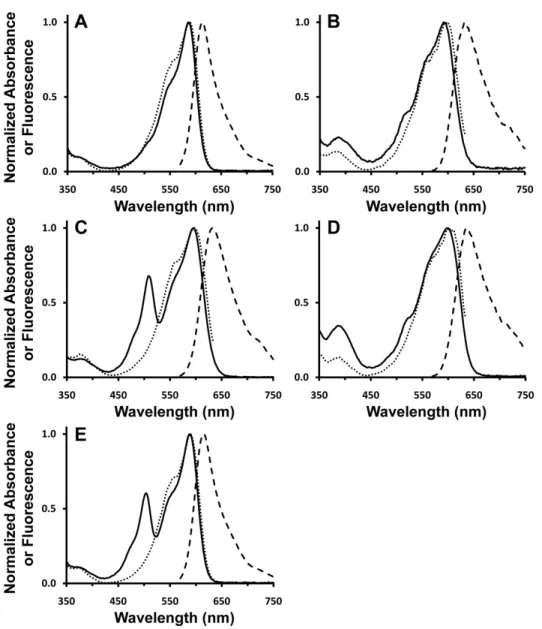
Recovery of Red Fluorescent Protein Chromophore Maturation Deficiency through Rational Design
We hypothesized that the identity of the amino acid at position 16 could be crucial to promote or inhibit red chromophore maturation. To investigate the effect of the AYC motif on chromophore maturation, we performed maturation experiments. No evidence for the presence of the red chromophore was observed in mPlumAYC as indicated by the absence of any absorption peak at > 550 nm (Fig. 2).
Thus, the introduction of the AYC motif into mPlum prevents the maturation of the red chromophore by inhibiting the second oxidation reaction, resulting in a faint yellow fluorescent protein containing only the green chromophore. As observed for mPlum, the ~390 nm peak overlaps with the 410 nm peak of the blue intermediate. To assess whether removing the H-bonding interaction between Glu16 and the chromophore would result in enhanced maturation to the red chromophore in mPlum, we prepared the point mutant mPlum-E16P and measured its absorption spectrum.
Therefore, removal of the Glu16-acylimine H-bond greatly enhanced red chromophore maturation in mPlum, resulting in a brighter RFP that matures almost exclusively to the red chromophore. This result indicates that ionization of the green chromophore occurs on a much faster time scale than chromophore formation. Thus, the maturation half-life of the anionic green chromophore is sufficient to accurately reflect the maturation half-life of the dehydration step leading to the neutral green chromophore (Figs. 1, 3 to 4).
Thus, a kinetic effect at the branch point of the mechanism (Fig. 1, box) must determine the efficiency of RFP chromophore maturation. At the same time, the maturation half-time of the green chromophore is prolonged in mPlum-E16P relative to mPlum at both pH 7.5 and pH 9.5. On balance, the AYC motif appears to favor the dehydration reaction leading to the formation of the green chromophore (Fig. 1, 3 to 4) over the second oxidation reaction (Fig. 1, 6 to 7) which ultimately leads to red chromophore formation .
Thus, sequestering the Lys70 side chain away from the chromophore results in the observed maturation deficiency. Among the residues involved in the AYC motif, position 217 has been shown to accelerate red chromophore maturation when mutated to alanine [17]. The search model used consisted of the PDB coordinates of mPlum (2QLG [39]) with the chromophore removed.
A and B) Introduction of the AYC motif results in π-stacking interactions between the chromophore and Tyr197 in both mPlumAYC (A) and mPlumAYC-E16A (B). A dashed line connects the NZ atom of Lys70 in mPlum with the CB2 atom of the mPlum red (C) or green (D) chromophore.
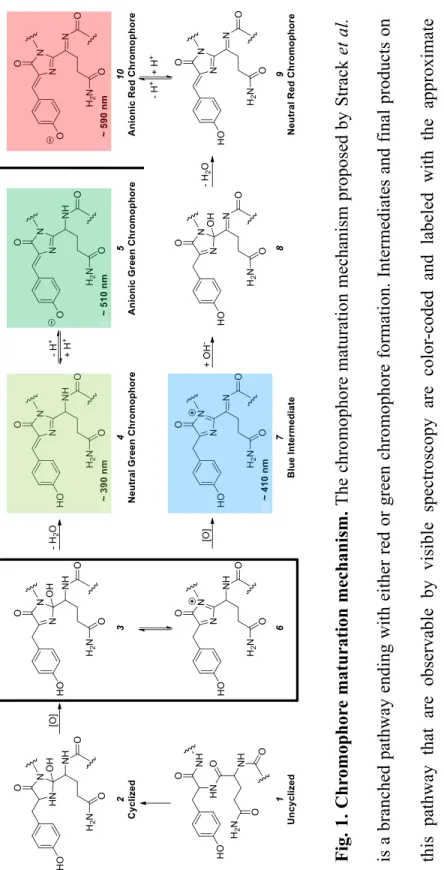
A Method for Rapid Identification of Monomeric Fluorescent Protein Mutants Guided by Computational Protein Design
Focused combinatorial libraries of surface mutations were made on a variant of the tetrameric red fluorescent protein DsRed;. Most natural FPs discovered so far are high-order oligomers [1] and although their oligomeric state does not significantly affect their ability to function as reporters of gene expression, it has a dramatic effect on the success of them as molecular tags [3, 5]. The elution profile shows that its oligomerization state in solution is more similar to mCherry than to any of the DsRed surface proteins discussed above (Fig. S2A).
The AB interface is the weaker of the two and its center occurs around residue 125. We hypothesized that computational design of the surface residues of any FP oligomeric Anthozoa class would lead to a set of surface-compatible mutations unable to support the oligomer wild type interfaces. Interfaces were generated for a molecule of the DsRed homotetramer using an implicit occlusion-based solvation model.
There were no prominent sequence-based differences between these 3 proteins and the rest of the sequences in M-Lib (Table S2). In contrast, 9 of the 22-membered R-Lib (41%) were minimally fluorescent, and 6 other R-Lib sequences showed no evidence of chromophore or exhibited zero quantum yield (Table S5). Therefore, a total of 97% of M-Lib sequences were more than minimally fluorescent compared to only 27% for R-Lib.
For most parameters measured for M-Lib, the distributions were observed to be negatively skewed (Table 2). With regard to the scoring function used to rank library members, four of the top ten ranked CPD sequences were among the top ten highest measured ΦF mutants in M-Lib (Table S2 and Table S4). For FPs, the excited state lifetime (the fluorescence lifetime) is much shorter than the rotational correlation time.
When homoFRET occurs, the polarization of incoming light is changed according to the orientation of the dipoles in the excited states in both molecules. In our expression system, we observe that the magnitude of the mCherry r versus DF slope is approximately six times greater than for DsRed (Table 1). Lazaridis T & Karplus M (1999) Discrimination of the native from misfolded protein models with an energy function including implicit solution.
The resulting schematic representation of the AC interface from application of the procedure shown in Fig. 3. Note that the b-sheets from the opposite subunits of the interface are stacked antiparallel instead of offset by ∼90° (as in the AB interface, Fig. S5).
